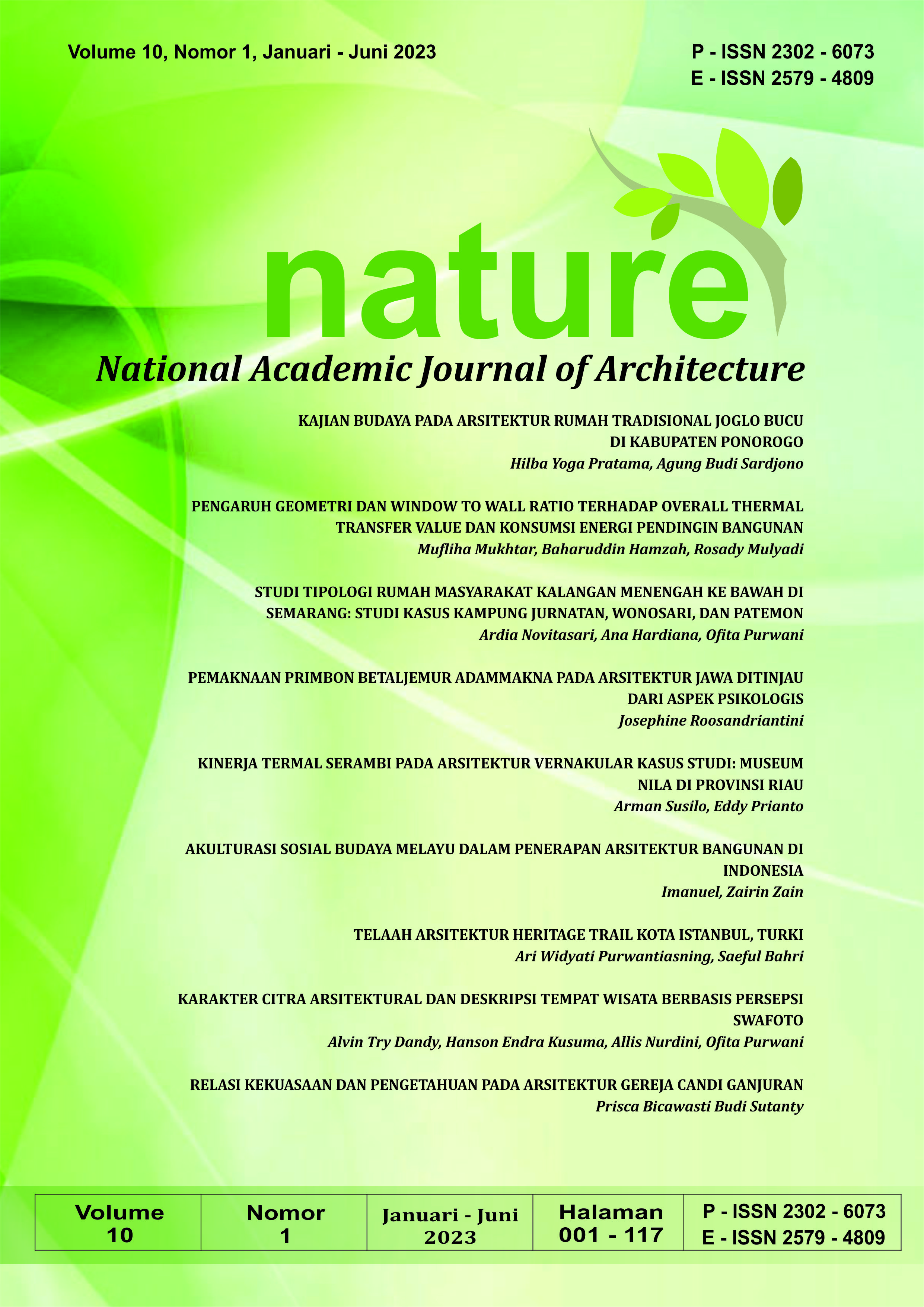KARAKTER CITRA ARSITEKTURAL DAN DESKRIPSI TEMPAT WISATA BERBASIS PERSEPSI SWAFOTO
Abstract
Selfie-oriented tourist destinations gained significant popularity among tourists and mass media in 2015. Selfie spot is the key attraction of these sites, which often takes inspiration from renowned landmarks and tourist destinations worldwide. This article explores the visual-architectural characteristics, the original reference of these selfie spots, and tourists’ perceptions regarding the selfie spots. The study is mixed methods research, consisting of qualitative and quantitative stages. In the qualitative stage, the data are collected through qualitative content analysis (QCA) of 15 videos gathered from a video-sharing platform and analyzed using QCA and open coding to identify the visual-architectural characteristics and tourists’ perceptions of selfie spots in the videos. In the quantitative stage, the data are collected through online questionnaires and analyzed using principal component analysis (PCA) and factor analysis (FA). This study finds that selfie spots show visual-architectural characteristics such as reference to foreign and romantic images. The study also finds that the selfie spots are described as either visually appealing or described faithfully in accordance with their actual shape and form.
Downloads
References
Bernhard, Bauer, dan Canestrini Duccio. 2019. “Copysites: tourist attractions in the age of their architectural reproducibility.” Journal of Tourism and Cultural Change 17 (1): 13–26. https://doi.org/10.1080/14766825.2019.1558020.
Bosker, Bianca. 2013. Original Copies: Architectural Mimicry in Contemporary China. University of Hawai’i Press.
Cohen, Erik. 1972. “Toward a Sociology of International Tourism.” Social Research 39 (1).
Creswell, John W., dan John David Creswell. 2018. Research Design Qualitative, Quantitative, and Mixed Methods Approaches. Thousand Oaks: SAGE.
Dinhopl, Anja, dan Ulrike Gretzel. 2015. “Changing Practices/New Technologies: Photos and Videos on Vacation.” In Information and Communication Technologies in Tourism 2015, diedit oleh Iis Tussyadiah dan Alessandro Inversini, 777–88. Springer. https://doi.org/10.1007/978-3-319-14343-9_56.
Eco, Umberto. 1986. Travels in Hyper Reality: Essays. San Diego: Harcourt.
Goeldner, Charles R., dan J. R. Brent Ritchie. 2011. Tourism: Principles, Practices, Philosophies. 12th ed. Hoboken: Wiley.
Groat, Linda, dan David Wang. 2013. Architectural Research Methods. 2nd ed. Hoboken: John Wiley & Sons.
Hasan, Md Kamrul, Shamsul Kamariah Abdullah, Tek Yew Lew, dan Md Faridul Islam. 2019. “The antecedents of tourist attitudes to revisit and revisit intentions for coastal tourism.” International Journal of Culture, Tourism and Hospitality Research 13 (2): 218–34. https://doi.org/10.1108/IJCTHR-11-2018-0151.
Hung, Wei-Li, Yi-Ju Lee, dan Po-Hsuan Huang. 2016. “Creative experiences, memorability and revisit intention in creative tourism.” Current Issues in Tourism 19 (8): 763–70. https://doi.org/10.1080/13683500.2013.877422.
Jackson, Donald A. 1993. “Stopping Rules in Principal Components Analysis: A Comparison of Heuristical and Statistical Approaches.” Ecology 74 (8): 2204–14. https://doi.org/10.2307/1939574.
Jang, SooCheong, dan Ruomei Feng. 2007. “Temporal destination revisit intention: The effects of novelty seeking and satisfaction.” Tourism Management 28 (2): 580–90. https://doi.org/10.1016/j.tourman.2006.04.024.
Kumar, Ranjit. 2011. Research Methodology: A Step-by-Step Guide for Beginners. 3rd ed. Thousand Oaks: SAGE.
Oh, Haemoon, Ann Marie Fiore, dan Miyoung Jeoung. 2007. “Measuring Experience Economy Concepts: Tourism Applications.” Journal of Travel Research 46 (2): 119–32. https://doi.org/10.1177/0047287507304039.
Pearce, Philip L., dan Uk-Il Lee. 2005. “Developing the Travel Career Approach to Tourist Motivation.” Journal of Travel Research 43 (3): 226–37. https://doi.org/10.1177/0047287504272020.
Peres-Neto, Pedro R., Donald A. Jackson, dan Keith M. Somers. 2005. “How many principal components? stopping rules for determining the number of non-trivial axes revisited.” Computational Statistics & Data Analysis 49 (4): 974–97. https://doi.org/10.1016/j.csda.2004.06.015.
“Rabbit Town: Antara tuduhan plagiarisme seni dan gegar ‘wisata selfie.’” 2018. 2018. https://www.bbc.com/indonesia/majalah-43639089.
Schreier, Margrit. 2012. Qualitative Content Analysis in Practice. Thousand Oaks: SAGE.
Tashakkori, Abbas, dan Charles Teddlie. 2009. Foundations of Mixed Methods Research: Integrating Quantitative and Qualitative Approaches in the Social and Behavioral Sciences. Thousand Oaks: SAGE.
Tussyadiah, Iis, dan Daniel Fesenmaier. 2009. “Mediating Tourist Experiences.” Annals of Tourism Research 36 (1): 24–40. https://doi.org/10.1016/j.annals.2008.10.001.
Urry, John, dan Jonas Larsen. 2011. The Tourist Gaze 3.0. 1 Oliver’s Yard, 55 City Road, London EC1Y 1SP United Kingdom: SAGE Publications Ltd. https://doi.org/10.4135/9781446251904.
Wang, Chaohui, Juan Liu, Lijiao Wei, dan Tingting Christina Zhang. 2020. “Impact of tourist experience on memorability and authenticity: a study of creative tourism.” Journal of Travel & Tourism Marketing 37 (1): 48–63. https://doi.org/10.1080/10548408.2020.1711846.
Wang, Ning. 1999. “Rethinking authenticity in tourism experience.” Annals of Tourism Research 26 (2): 349–70. https://doi.org/10.1016/S0160-7383(98)00103-0.
Windratie. 2015. “Taman Amaryllis Gunung Kidul Rusak Diserbu Pasukan Tongsis.” cnnindonesia.com. 2015. https://www.cnnindonesia.com/gaya-hidup/20151128152300-269-94628/taman-amaryllis-gunung-kidul-rusak-diserbu-pasukan-tongsis.
Yousaf, Salman, dan Xiucheng Fan. 2020. “Copysites/duplitectures as tourist attractions: An exploratory study on experiences of Chinese tourists at replicas of foreign architectural landmarks in China.” Tourism Management 81 (Desember): 104179. https://doi.org/10.1016/j.tourman.2020.104179.
Copyright (c) 2023 Alvin Try Dandy, Hanson Endra Kusuma, Allis Nurdini, Ofita Purwani

This work is licensed under a Creative Commons Attribution-ShareAlike 4.0 International License.
By submitting your manuscript to our journal, you are following Copyright and License











